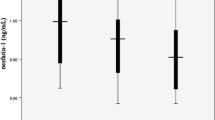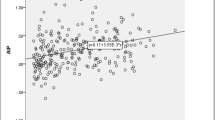Abstract
Objective
Asprosin, a recently discovered adipokine, stimulates the release of hepatic glucose. The purpose of the current research was to determine the relation between serum asprosin and obstructive sleep apnea syndrome (OSAS).
Methods
The current investigation enrolled 152 patients with OSAS and 97 control subjects. Serum asprosin concentrations were measured and analyzed.
Results
Higher serum asprosin concentrations were found in patients with OSAS than in the controls. Logistic regression analysis demonstrated that serum asprosin concentrations were associated with an increased risk of OSAS. Patients with severe OSAS had significantly increased asprosin compared to mild and moderate groups. The group with moderate OSAS showed higher serum asprosin levels than the group with mild OSAS. Pearson correlation analysis demonstrated a positive relation between serum asprosin and disease severity. Simple linear regression analyses showed a significant correlation between serum asprosin with body mass index (BMI), fasting plasma glucose (FPG), homeostasis model assessment of insulin resistance (HOMA-IR), triglycerides (TG), and apnea-hypopnea index (AHI), and negatively correlated with high-density lipoprotein cholesterol (HDL-C). Multiple linear regression analysis revealed a significant correlation between serum asprosin with BMI, FPG, HOMA-IR, TG, AHI, and HDL-C.
Conclusion
There is a significant correlation between serum asprosin with the presence and severity of OSAS.

Similar content being viewed by others
Data availability
Data are available upon reasonable request.
References
Caples SM, Gami AS, Somers VK (2005) Obstructive sleep apnea. Ann Intern Med 142:187–197
Young T, Palta M, Dempsey J, Skatrud J, Weber S, Badr S (1993) The occurrence of sleep-disordered breathing among middle-aged adults. N Engl J Med 328:1230–1235
Martinez D, Klein C, Rahmeier L, da Silva RP, Fiori CZ, Cassol CM, Gonçalves SC, Bos AJG (2012) Sleep apnea is a stronger predictor for coronary heart disease than traditional risk factors. Sleep Breath 16:695–701
Salerno FG, Carpagnano E, Guido P, Bonsignore MR, Roberti A, Aliani M, Vignola AM, Spanevello A (2004) Airway inflammation in patients affected by obstructive sleep apnea syndrome. Respir Med 98:25–28
Romere C, Duerrschmid C, Bournat J, Constable P, Jain M, Xia F, Saha PK, del Solar M, Zhu B, York B, Sarkar P, Rendon DA, Gaber MW, LeMaire SA, Coselli JS, Milewicz DM, Sutton VR, Butte NF, Moore DD, Chopra AR (2016) Asprosin, a fasting-induced glucogenic protein hormone. Cell 165:566–579
Lee T, Yun S, Jeong JH, Jung TW (2019) Asprosin impairs insulin secretion in response to glucose and viability through TLR4/JNK-mediated inflammation. Mol Cell Endocrinol 486:96–104
Lavie P, Lavie L (2008) Cardiovascular morbidity and mortality in obstructive sleep apnea. Curr Pharm Des 14:3466–3473
Lin QC, Chen LD, Yu YH, Liu KX, Gao SY (2014) Obstructive sleep apnea syndrome is associated with metabolic syndrome and inflammation. Eur Arch Otorhinolaryngol 271:825–831
Inancli HM, Enoz M (2010) Obstructive sleep apnea syndrome and upper airway inflammation. Recent Patents Inflamm Allergy Drug Discov 4:54–57
Petrof BJ, Hendricks JC, Pack AI (1996) Does upper airway muscle injury trigger a vicious cycle in obstructive sleep apnea? A hypothesis. Sleep 19:465–471
Sekosan M, Zakkar M, Wenig BL, Olopade CO, Rubinstein I (1996) Inflammation in the uvula mucosa of patients with obstructive sleep apnea. Laryngoscope 106:1018–1020
Puig F, Rico F, Almendros I, Montserrat JM, Navajas D, Farre R (2005) Vibration enhances interleukin-8 release in a cell model of snoring-induced airway inflammation. Sleep 28:1312–1316
Nadeem R, Molnar J, Madbouly EM, Nida M, Aggarwal S, Sajid H, Naseem J, Loomba R (2013) Serum inflammatory markers in obstructive sleep apnea: a meta-analysis. J Clin Sleep Med 9:1003–1012
Jung TW, Kim HC, Kim HU, Park T, Park J, Kim U, Kim MK, Jeong JH (2019) Asprosin attenuates insulin signaling pathway through PKCδ-activated ER stress and inflammation in skeletal muscle. J Cell Physiol 234:20888–20899
Li X, Liao M, Shen R et al (2018) Plasma asprosin levels are associated with glucose metabolism, lipid, and sex hormone profiles in females with metabolic-related diseases. Mediat Inflamm 2018:7375294
Wang M, Yin C, Wang L, Liu Y, Li H, Li M, Yi X, Xiao Y (2019) Serum asprosin concentrations are increased and associated with insulin resistance in children with obesity. Ann Nutr Metab 75:205–212
Kaštelan S, Tomić M, Gverović Antunica A, Salopek Rabatić J, Ljubić S (2013) Inflammation and pharmacological treatment in diabetic retinopathy. Mediat Inflamm 2013:213130
Code availability
Not applicable.
Author information
Authors and Affiliations
Contributions
Li Zhang planned this study. Jurong Ding and Shanmei Wang collected the data and performed the ELISA measurement. Wei Tan and Xinmiao Song did the statistical work. All authors approved the paper publication.
Corresponding author
Ethics declarations
Conflict of interest
The authors declare no conflict of interest.
Additional information
Publisher’s note
Springer Nature remains neutral with regard to jurisdictional claims in published maps and institutional affiliations.
Rights and permissions
About this article
Cite this article
Ding, J., Wang, S., Tan, W. et al. Association of serum asprosin concentrations with obstructive sleep apnea syndrome. Sleep Breath 25, 1893–1896 (2021). https://doi.org/10.1007/s11325-021-02298-z
Received:
Revised:
Accepted:
Published:
Issue Date:
DOI: https://doi.org/10.1007/s11325-021-02298-z




